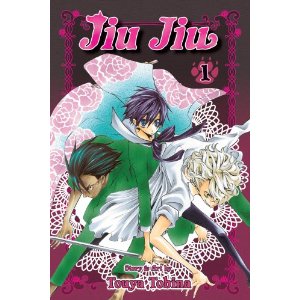Oresama Teacher #10 by Izumi Tsubaki
Oresama Teacher has settled into a bit of a predictable formula, but Tsubaki’s particular brand of ridiculous idiocy never fails to cheer me up. This volume focuses on Yui, the ninja and erstwhile spy on the Public Morals Club for the fiendish school council. He decides that Mafuyu and Hayasaka have to endure his particular brand of ninja training, with hilarious results as his modern substitutes for traditional ninja training apparatus never seem to quite work out. Mafuyu has to struggle to get certification for the Public Morals Club, which involves tangling with Hojo, a student council lackey with a major crush on Yui. It is amusing, because while Mafuyu is incredibly dense when it comes to her own feelings, she quickly figures out the undercurrents between Hojo and Yui while Yui remains absolutely oblivious. Deranged ninja antics are always good for a laugh, and while it was nice to have the focus of this volume on a different character, I’m hoping that the next volume swings back to feature more scenes with Hayasaka and Takaomi. I’d also like to see some more scenes that show Mafuyu’s emotional development as she works through her issues with juvenile delinquency. Also, I feel like there was less face-punching in this volume than I’ve come to expect from Oresama Teacher.
A Devil and Her Love Song #4 by Miyoshi Tomori
Ordinarily I would start to get a little frustrated with a series where characters spend a large chunk of time discussing their feelings and interactions, but in A Devil and Her Love Song Maria’s forthright pronouncements and abrasive personality put her into some interesting situations. I might not feel as much of an emotional connection to this story as compared to some of my other favorite shoujo manga, but I do enjoy seeing how Maria’s presence seems to force the people around her to change and grow. In this volume, we are still dealing with the Machiavellian shenanigans around a school concert that the media is about to film. Maria’s evil teacher is planning on using her alleged “reformation” as a way of bringing favorable publicity to the school, and Hana is going along with the plan so she can show herself as a saintly angel of forgiveness. The only problem is that Maria is totally aware of the plan and decides to participate willingly just due to her desire to sing with her classmates. Maria encourages her previous bully Ayu to express her true feelings, with the result that the entire set-up gets derailed when Ayu can’t stand the blatant hypocrisy and lies around her. Maria faces even more obstacles, but she ends up putting “a lovely spin” on the whole situation, managing to salvage the concert. It’ll be interesting to see the fallout resulting from this volume, since various classmates have had emotional breakthroughs and learned more about themselves. I’m predicting that Maria will never be popular, but I’m guessing that her circle of friends will grow a bit and she’s going to treasure the loyalty of the people who actually appreciate her forthright yet slightly odd personality. Overall, this was yet another strong volume for this series.
Review copies provided by the publisher.


